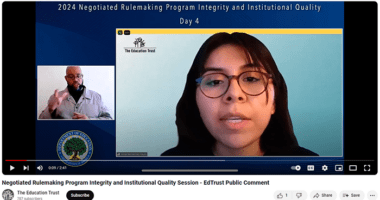A December Budget Deal to Remember
It’s December in Washington, so what does that mean? You guessed it, budget negotiations. But wait, could it be … there’s a deal? An honest to goodness deal that might allow Congress to work on something other than the budget and debt ceiling for the next two years?
It appears that the specter of reliving October’s colossal congressional meltdown and the resulting 16-day federal government shutdown provided the cover necessary for Sen. Patty Murray (D-Wash.) and Rep. Paul Ryan (R-Wis.) to negotiate a deal. And, all things considered, it’s not a bad deal for education. It provides $469 billion in funding for non-defense programs in fiscal year 2014, which is about $22.4 billion more than would have been allowed under sequestration. For fiscal year 2015, it provides about $9 billion additional dollars before returning to the sequestration cap established for fiscal year 2016. But, that gives Congress two additional years to come up with a permanent deal to address sequestration. It also provides the administration some budgeting stability for the next two years and the ability to restore cuts to programs, like Head Start and Impact Aid, which have suffered under sequestration.
The deal doesn’t speak specifically to individual education programs, so we’ll have to wait and see how the appropriators divvy up dollars among K-12 and higher education programs. But the $22.4 billion increase should mean more money for education overall. Also, it’s notable that unlike prior deals, the Ryan-Murray deal does not raid the student financial-aid programs for savings that can be applied to deficit reduction.
There are two identified offsets that are higher education related. The first would, beginning July 1, 2014, reduce the amount of money guaranty agencies can make when they rehabilitate a defaulted loan under the Federal Family Education Loan (FFEL) program. The second would eliminate the requirement (and associated mandatory funding) that the Department of Education guarantee certain nonprofit loan servicers a portfolio of at least 100,000 loans to service.
Both of these offsets will save the government money, but more important, they will not harm students. Students will remain eligible for the same amount of aid as before this deal, and they will continue to retain all the same rights and responsibilities that come with federal student aid dollars. These are the kinds of offsets Congress should use in the future if it must take dollars out of the education budget as opposed to, say, closing corporate tax loopholes or identifying waste in other areas of the federal budget.
It’s high time Congress got back to business as usual. Although Sen. Murray and Rep. Ryan crafted this deal outside of the normal budget and appropriations funding cycle, it takes strides toward putting Congress back on the path to normalcy. Let’s hope that keeping student aid off the chopping block becomes part of Congress’ new normal.












